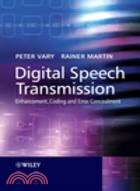| FindBook |
有 1 項符合
DIGITAL SPEECH TRANSMISSION: ENHANCEMENT, CODING AND ERROR CONCEALMENT的圖書 |
 |
DIGITAL SPEECH TRANSMISSION: ENHANCEMENT, CODING AND ERROR CONCEALMENT 作者:PETER VARY 出版社:全華經銷 出版日期:2006-03-21 規格:25*17.5cm |
| 圖書館借閱 |
| 國家圖書館 | 全國圖書書目資訊網 | 國立公共資訊圖書館 | 電子書服務平台 | MetaCat 跨館整合查詢 |
| 臺北市立圖書館 | 新北市立圖書館 | 基隆市公共圖書館 | 桃園市立圖書館 | 新竹縣公共圖書館 |
| 苗栗縣立圖書館 | 臺中市立圖書館 | 彰化縣公共圖書館 | 南投縣文化局 | 雲林縣公共圖書館 |
| 嘉義縣圖書館 | 臺南市立圖書館 | 高雄市立圖書館 | 屏東縣公共圖書館 | 宜蘭縣公共圖書館 |
| 花蓮縣文化局 | 臺東縣文化處 |
|
|
- 圖書簡介
The enormous advances in digital signal processing (DSP) technology have contributed to the wide dissemination and success of speech communication devices – be it GSM and UMTS mobile telephones, digital hearing aids, or human-machine interfaces. Digital speech transmission techniques play an important role in these applications, all the more because high quality speech transmission remains essential in all current and next generation communication networks.
Enhancement, coding and error concealment techniques improve the transmitted speech signal at all stages of the transmission chain, from the acoustic front-end to the sound reproduction at the receiver. Advanced speech processing algorithms help to mitigate a number of physical and technological limitations such as background noise, bandwidth restrictions, shortage of radio frequencies, and transmission errors.
Digital Speech Transmission provides a single-source, comprehensive guide to the fundamental issues, algorithms, standards, and trends in speech signal processing and speech communication technology. The authors give a solid, accessible overview of
fundamentals of speech signal processing
speech coding, including new speech coders for GSM and UMTS
error concealment by soft decoding
artificial bandwidth extension of speech signals
single and multi-channel noise reduction
acoustic echo cancellation
This text is an invaluable resource for engineers, researchers, academics, and graduate students in the areas of communications, electrical engineering, and information technology. - 目次
1 Introduction.
2 Models of Speech Production and Hearing.
2.1 Organs of Speech Production.
2.2 Characteristics of Speech Signals.
2.3 Model of Speech Production.
2.4 Anatomy of Hearing.
2.5 Performance of the Auditory Organs.
Bibliography.
3 Spectral Transformations.
3.1 Fourier Transform of Continuous Signals.
3.2 Fourier Transform of Discrete Signals.
3.3 Linear Shift Invariant Systems.
3.4 The z-Transform.
3.5 The Discrete Fourier Transform.
3.6 Fast Convolution.
3.7 Cepstral Analysis.
Bibliography.
4 Filter Banks for Spectral Analysis and Synthesis.
4.1 Spectral Analysis Using Narrow-Band Filters.
4.2 Polyphase Network Filter Banks.
4.3 QuadratureMirror Filter Banks.
Bibliography.
5 Stochastic Signals and Estimation.
5.1 Basic Concepts.
5.2 Expectations andMoments.
5.3 Bivariate Statistics.
5.4 Probability and Information.
5.5 Multivariate Statistics.
5.6 Stochastic Processes.
5.7 Estimation of Statistical Quantities by Time Averages.
5.8 Power Spectral Densities.
5.9 Estimation of the Power Spectral Density.
5.10 Statistical Properties of Speech Signals.
5.11 Statistical Properties of DFT Coe.cients.
5.12 Optimal Estimation.
Bibliography.
6 Linear Prediction.
6.1 Vocal TractModels and Short-TermPrediction.
6.2 Optimal Prediction Coe.cients for Stationary Signals.
6.3 Predictor Adaptation.
6.4 Long-TermPrediction.
Bibliography.
7 Quantization.
7.1 Analog Samples and Digital Presentation.
7.2 Uniform Quantization.
7.3 Non-uniformQuantization.
7.4 OptimalQuantization.
7.5 Adaptive Quantization.
7.6 Vector Quantization.
7.6.1 Principle.
Bibliography.
8 Speech Coding.
8.1 Classi.cation of Speech Coding Algorithms.
8.2 Model-Based Predictive Coding.
8.3 Di.erentialWaveform Coding.
8.4 Parametric Coding.
8.5 Hybrid Coding.
8.6 Adaptive Post.ltering.
Bibliography.
9 Error Concealment and Softbit Decoding.
9.1 Hardbit Source Decoding.
9.2 Conventional Error Concealment.
9.3 Softbits and L-Values.
9.4 Softbit Source Decoding (SD).
9.5 Application toModel Parameters.
9.6 Further Improvements.
Bibliography.
10 Bandwidth Extension of Speech Signals (BWE).
10.1 Narrowband versusWideband Telephony.
10.2 Speech Coding with Integrated BWE.
10.3 BWE without Auxiliary Transmission.
Bibliography.
11 Single and Dual Channel Noise Reduction.
11.1 Introduction.
11.2 LinearMMSE Estimators.
11.3 Speech Enhancement in the DFT Domain.
11.4 Optimal Non-Linear Estimators.
11.5 Joint Optimum Detection and Estimation of Speech.
11.6 Computation of Likelihood Ratios.
11.7 Estimation of the A Priory Probability of Speech Presence.
11.8 VAD and Noise Estimation Techniques.
11.9 Dual-Channel Noise Reduction.
Bibliography.
12 Multi-Channel Noise Reduction.
12.1 Introduction.
12.2 Spatial Sampling of Sound Fields.
12.3 Beamforming.
12.4 PerformanceMeasures and Spatial Aliasing.
12.5 Design of Fixed Beamformers.
12.6 Adaptive Beamformers.
Bibliography.
13 Acoustic Echo Control.
13.1 The Echo Control Problem.
13.2 Evaluation Criteria.
13.3 TheWiener Solution.
13.4 The LMS and NLMS Algorithm.
13.5 Convergence Analysis and Control of the LMS Algorithm.
13.6 Geometric Projection Interpretation of the NLMS Algorithm.
13.7 The A.ne Projection Algorithm.
13.8 Least-Squares and Recursive Least-Squares Algorithms.
13.9 Block Processing and Frequency-Domain Adaptive Filters.
13.9.1 Block LMS Algorithm.
13.10 Additional Measures for Echo Control.
13.11 Stereophonic Acoustic Echo Control.
A Codec Standards.
B Speech Quality Assessment.
Bibliography.
|








